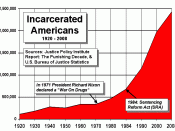Crime has been a defining characteristic of modern America. It has claimed thousands of lives and has cost billions of dollars. The U.S. "correctional" population is at a record high. During the past two decades, the prison population has grown more rapidly than at any noted time in history. This growth resulted in the massive new prison expansion program, which was implemented in order to deal with overcrowding in prisons. The present day role of our prison system is one of deterrence. By being "tough on crime" with stiffer drug laws, tougher parole requirements, mandatory minimum sentences, "three strikes" laws and other legislation, our nation, supposedly, strives to lower the crime rate. The millions of Americans behind bars, the majority of them nonviolent offenders, means jobs for depressed regions and major profits for private contractors wanting to "cash in" on the opportunity. Our current prison-based rehabilitation programs have not kept up with this growing number of offenders.
Our "corrections" system is failing; we are not rehabilitating prisoners. Instead, we are simply housing inmates, then releasing them back into society having received little or no job training, drug treatment, or education. Many are unable to find jobs and are barred by law from living in public housing projects, so they quickly return to crime. This pattern is a major factor in recidivism rates which have barely changed in over twenty years (The Justice Department's Bureau of Justice Statistics.)
There are many promising therapeutic programs that, if properly and sufficiently implemented, could deal with these issues. These programs have the potential to help maintain control of and improve the safety in prisons, reduce recidivism rates, and help inmates address a range of problems that can affect their ability to become productive members of society.
Almost 6.6 million men and women made...


